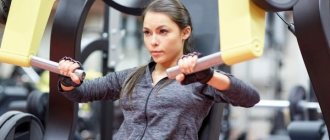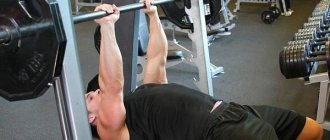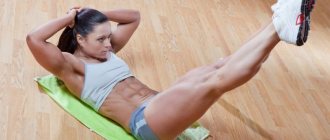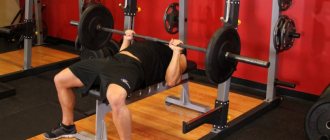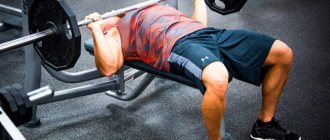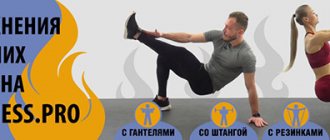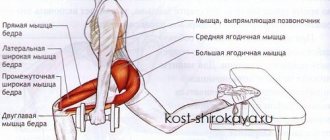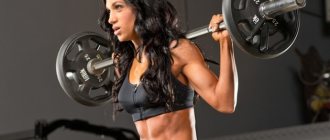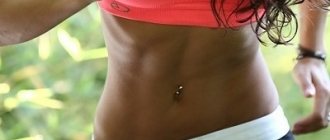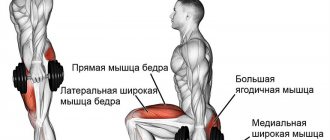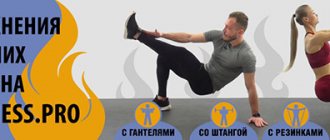Technique and features of performing the squat-scissors exercise
Today I want to talk about such a basic and technically complex exercise as scissor squats - lunge squat or, as they are usually called, lunges.
“Scissor squats,” like regular squats, come in different forms—with a barbell on your back and front squats—with a barbell on your chest, with dumbbells in your hands, with free weights, or in a Smith machine, which I perform.
The exercise is mainly performed to stimulate the gluteus maximus muscles. Naturally, it does not isolate their work, but allows you to qualitatively shift the emphasis (and distribute it between the muscles of the front or back of the thigh, depending on the stance).
The downside of the exercise is the technical complexity, since the main load falls on one leg and you have to make an effort to maintain balance, especially when it comes to approaches with high intensity and heavy working weight. The undoubted advantages are that less weight (after all, the main movement is performed by one leg) creates less axial load on the spine, and it is also easier to control the correct position of the back. In addition, the exercise allows you to better concentrate on working the gluteus maximus (which is “felt” better than in the same squats).
Let's compare scissor squats in various variations:
The first option, where the angle of the front leg between the knee and hip joint is 90 degrees, is called balanced. Here, the work of the antagonist muscles is distributed evenly and therefore you will equally load the muscles of the back of the thigh and quadriceps.
In the second photo, when the knee slightly extends beyond the toe of the leg in front, it is a knee-dominant option. If your quadriceps muscle does not dominate in relation to the back of the thigh, then you can safely perform this type of exercise so that the quadriceps is accentuated in the work (and load the gluteals hip-dominantly using the same Romanian deadlift).
I take a wide sliding step forward to form an angle of slightly more than 90 degrees and begin the movement by flexing the hip joint smoothly, without acceleration, emphasizing the eccentric phase (stretching the muscles of the back of the thigh and gluteal), after which I contract the listed muscle groups and return to the original position.
I keep my back in a neutral position throughout the entire range of motion, preventing both flexion and hyperextension in the lumbar spine, maintaining a natural arch in the lower back.
I perform squats tonedly - 3 sets of 10 repetitions with a delay at the bottom, since I achieve the main training volume through exercises such as straight leg deadlifts, pulling the leg back in a block and reverse hyperextension.
Experiment with different angles of placing your legs, both wide and narrow, choose both knee-dominant and hip-dominant types of execution in various movements, so that the gluteal muscles always receive an intense load, but at the same time with different muscle groups of the hips and grow faster than the legs.
I’ll also tell you about common mistakes that can be made when performing this type of squats:
- exclude your knee from touching the floor (and especially from hitting);
- when lifting up, the supporting leg takes on the load;
- excessive straightening of the knee at the top;
- deviation of the pelvis to the side when you “sit down” on the buttock;
- strong arch in the lower back.
Scissor squats can be used as the main exercise in your training volume, while increasing either the working weight or the number of repetitions. Or, as I use them - in tonic mode, to further emphasize the work of the gluteal muscles.
Take into account your individual characteristics, consciously selecting both types of exercises and options for their implementation in order to achieve the results you need.
Source: https://ironargument.ru
Avoiding injuries
Lunges with dumbbells, like any other type of lunge, place increased stress on the ligaments of the knee joints. In this regard, they are more dangerous than, say, squats. This is explained by the fact that during squats, the weight of the body and weights are distributed on two legs, and when doing lunges, you focus the entire load on one leg. Of course, the muscles are delighted with this, but weak ligaments may suffer.
Therefore, to prevent injury, use the following recommendations:
Avoid lunging with dumbbells if you have a recent knee injury.
If there were injuries, but for a long time, do the exercise extremely carefully and stop if the slightest discomfort occurs. Health, you understand, is more expensive. Before you start training, you need to warm up the muscles and provoke the release of joint lubrication (synovial fluid)
To do this, we squat and do lunges without weights, rotate our feet and shins, bend forward, etc. It will take five minutes, but the effect of the workout will be much higher, and the likelihood of getting injured is lower. When working with heavy weights, do not take steps. That is, both legs remain in place and your dumbbell lunges automatically transform into scissor squats. If you have not practiced lunges before, practice the technique without weight first. If pain, discomfort or any other signals occur that should not normally exist, stop the exercise.
If, due to problem knee joints, lunges are not suitable for you, then you can try replacing this exercise by abducting your legs (swings) while standing back, forward, or to the sides. This can be done in a special simulator or on a lower block. To work the buttocks, lunges can be replaced with a gluteal bridge. But, since every injury is individual, there are no universal recommendations, and therefore it is better to consult a doctor.
Actually, let's move on to a description of how to do lunges correctly.
Scissor squats
Scissor squats are a variation of squats that place maximum stress on the gluteal muscles and thighs. Despite the fact that this exercise migrated to fitness from weightlifting, it is practiced mainly by girls. Men use variations in which most of the load is transferred to the quadriceps.
What muscles are involved?
The load is divided between three muscle groups, namely:
- Gluteal muscles;
- Hamstrings;
- Quadriceps femoris.
The core stabilizer muscles are also used to keep the body in the correct position.
You can do the exercise either with a free barbell or in a Smith machine. If you perform in a Smith machine, you will be able to better concentrate on proper technique, since this way you almost completely turn off the core stabilizer muscles.
Scissor squats, due to their technique, place very strong pressure on the knee joints. Even with the correct technique, the load is still noticeable. Therefore, this exercise is not recommended for those people who have any knee problems or injuries.
In addition, the fact that you are holding the barbell on your shoulders creates some stress on the spine. Listen carefully to your feelings while doing it, and don’t force yourself to do the exercise.
Execution technique
Scissor squats with a barbell are performed as follows:
- Equip a barbell with a suitable weight and place it on the trapeze. For greater convenience, you can mount the barbell on a power rack that is used in a barbell squat;
- Place your feet shoulder-width apart;
- Step one foot forward. Place your foot so that during the squat your knee does not go beyond the line of your toes;
- The knee of the second leg should almost touch the floor during a squat;
- With your legs positioned correctly, pay attention to the correct position of your back. The spine is straight, and there is a natural deflection in the lumbar region;
- While lowering down, try not to tilt your body forward;
- As you inhale, lower yourself down. The leg standing behind always rests on the toe, without landing on the heel;
- As you exhale, return to the starting position. The legs remain in their places;
- Do the required number of repetitions and perform by switching legs.
Scissor squats can be performed on a Smith machine. In this case, you do not have to monitor the position of your back - since the bar is securely fastened in the machine. With this option it will be much easier for you to master the technique.
There is also a variation of the scissors execution when using dumbbells. This method is much simpler, since here it is much more convenient for you to maintain balance. Dumbbells hang freely along the body in straight arms. This is ideal for practicing proper squat technique.
Source: https://fitneszon.ru
Muscle work
When you scissor squat, the muscles that primarily work are the quadriceps, hamstrings, and gluteus maximus. They flex and extend the knee and hip, and help you lower yourself under control and rise up correctly from the bottom position. Additionally, the core stabilizer muscles are involved in the movement. If you do an exercise with a free barbell, their work is noticeable more, if in a Smith machine, then correspondingly less, since the trajectory of the projectile is fixed.
Muscles working during the exercise.
You can shift the emphasis of the load to the front or back muscle group. It depends on the width of your legs. The further the leg is set back, the more the gluteal muscles and the back of the thigh are involved. By bringing your legs closer together, you force your quadriceps to work.
As a word of caution, the step-up, like any other lunge or barbell squat, places significant stress on the knee joints. Of course, proper technique should minimize this, but it is best to avoid this exercise if you have knee pain or injury. Also, carrying weight on your shoulders puts compression on your spine. Pay attention to this if you have back problems.
Scissor squats with dumbbells
- We lift dumbbells from the floor. We place our legs approximately the width of the pelvis, and, without changing the distance between the legs, we take a sliding step back with one leg.
- We tilt the body forward by about 15 - 20 degrees. Your pelvis, body, shoulder girdle, neck and head should be in one line. That is, the spine should be in a neutral position throughout the exercise.
- The toe of the supporting front leg looks straight, the weight over the entire foot should be distributed evenly. The heel of the back leg is lifted off the floor. In this exercise, the back leg plays the role of support, and we need it more to maintain body balance.
- Try to relax your back leg as much as possible, shifting the emphasis of the weight of your body and dumbbells when moving both down and up to the front leg. If necessary, during the exercise, you can shift a little more emphasis to the back leg and help it perform the exercise, making the task easier for the front leg.
- Inhaling, we lower ourselves down. Please note that there should be no forward movement. Imagine that your thoracic region is resting against a wall, and it should move straight down. Go as low as possible until your back remains neutral.
- To give a general recommendation, the thigh of the front leg, when moving down, should become parallel to the floor or be slightly above parallel to the floor. When moving both down and up, the body maintains an inclination of 15 - 20 degrees. The shin of the front leg can also be at a slight inclination of 10 - 15 degrees.
- In the lower position, take a short pause for a split second, stop, and, tensing the gluteal muscles and the front of the thigh, rise up to the starting position, maintaining a slight bend in the knee and hip joints.
Take your time, watch your breathing. Feel how your buttocks and the muscles of the front of your thigh tighten during the exercise.
Source: https://leaderfit.ru
Useful tips
The exercise itself is not difficult, however, it still requires the correct technique. At first, it is recommended to perform under the supervision of a trainer or a more experienced friend to eliminate mistakes:
- You can only train one leg. This is very important for those who have muscle imbalances. Train the left or right leg separately, achieving the desired volumes.
- Follow breathing technique. This will allow you to get maximum results.
- The gaze is directed forward. The neck is straight, the head looks straight. A shift in gaze can negatively affect the position of the body. By bending the body forward, the load on the knee joints increases.
Sources:
https://bodybuilding-and-fitness.ru/uprazhneniya/vypady-nozhnicy.html https://fitnavigator.ru/baza-uprazhnenij/prisedanija-nozhnicy.html https://fitspine.ru/uprazhnenija/bazovye/prisedanija- nozhnicy-so-shtangoj-v-smite-s-ganteljami/
Lunges with a barbell in the Smith machine. How to pump up your buttocks. Exercise for the buttocks
As many people know, in order to pump up your buttocks you need to spend time training in the gym.
One of the effective exercises for sculpted buttocks is the so-called lunges with a barbell in a Smith machine. I want to write about an exercise for the buttocks that kills gluteus maximus completely. I’ve been doing lunges with a barbell for two years, and every time after lunges in Smith, everything hurts in the morning (in general, pain is not an indicator of a good workout, of course). So, in this article I will talk about how to perform lunges with a barbell correctly for girls and what to pay attention to in order for Smith lunges to be truly effective.
How to perform lunges with a barbell in Smith:
Variant of lunges with a barbell for weight: 3 sets of 10-12 reps, stopping one approach before complete failure. There may be a pyramid with increasing weight or decreasing it and increasing the number of repetitions.
Variation of lunges with a barbell for relief: multiple repetitions with moderate weight until burning, and a few more repetitions on top. 3 sets of 15-25 repetitions.
Variants of the exercise “Lunges with a barbell in the Smith machine”
You can vary the width of your legs while performing lunges - move the back leg far or not very far, and also change the tilt of the body. You can do a full lunge, or you can squat in a scissors position without returning your leg to the starting position.
You can use a stepper for the front or back leg. But it’s better to start doing smith lunges with something simple.
Possible mistakes when performing lunges with a barbell:
- When lunging with a barbell, the knee of the front leg goes beyond the toe.
- Moving the pelvis to the side when squatting. It is necessary to control the vector, only up and down.
- Too much weight when performing this exercise for the buttocks. The bar is fixed and there are stoppers, so there is a temptation to take more weight, which can be fraught.
- Do heavy lunges with a barbell if you already have heavy knee-dominant exercises in your program - squats, classic. deadlift Well, this is not exactly an error, but it may be overload.
Follow the simple rules of performing the lunge exercise with a barbell, and you can pump up the buttocks of your dreams :-))
Source: https://slimgirls.ru
Exercise options
It’s best to alternate classic forward lunges with dumbbells with other lunge variations that will help provide a more varied load. There are such exercise options:
Back lunges. In this case, you will need to step not with your working leg forward, but with your supporting leg and back. In this case, there will be no moment of lowering the foot of the working leg to the floor, and this will help reduce the load on the joints. However, the working leg will be constantly under tension, and unlike the classical variation, it will not be unloaded until the end of the exercise. The best option is to alternate lunges forward and backward.
Lunges with the working leg on a platform. This exercise allows you to better stretch and work your gluteal muscle. Lunges with a supporting leg on a bench, also known as Bulgarian lunges. This option increases the load on the working leg, while maximizing the load on the supporting leg.
Walking or dynamic lunges
Those who want to get rid of excess fat can pay attention to dynamic lunges with dumbbells or weights. In this exercise, you will additionally have to stabilize the position of your torso as you perform it.
Scissor squats
Until the legs are switched, the leg standing behind does not lower to the full foot.
The position of the legs should be quite long, for example, with a height of 185 centimeters, the distance between the legs should be about 120-130 centimeters. From the frontal view, the legs should not be in line, the width of the stance should be about half the width of the shoulders, while the foot of the front leg should be slightly turned inward for greater stability. If you look from the side, the shin of the leg that is in front should be tilted back, that is, at an angle of about 70-80 degrees to the athlete. The back leg should be positioned so far back that the angle between the floor line and the hip is approximately 40 degrees, while the shin of the back leg will be at an even sharper angle to the floor.
The body should be kept strictly in a vertical plane. From a subjective point of view, this position looks as if you are tilted slightly backward. The movements are performed strictly up and down until the squat is not full and not fully straightened. The specificity of this exercise is that the main working joint will not be the knee, but the hip. There should be no forward movements of the body either during squats or during lifting.
For the hamstrings to start working most actively, it usually takes about 2-3 weeks of doing this exercise, 2 workouts per week. This applies to the biceps of the thigh of the front leg. Until this effect is achieved, no matter how correctly you perform the exercises, the extensor of the leg that stands behind will mainly work. It will push your body forward and upward. This vector is usually optimally balanced by the extensor of the front leg as you push yourself up, trying not to fall forward.
When performing these squats, try to avoid pulling forward. Therefore, to begin with, take a light weight that is comfortable for you. Mastering this technique requires some effort, but it has a fairly definite meaning, because the hamstrings actually don’t require that many exercises. These squats also have a very good effect on both the gluteal muscles and hips. In addition, such squats improve your coordination very well. It is also recommended to alternate scissors with classic squats in order to effectively work not only large but also small muscles.
Modern conditions for business development are erasing the boundaries of states. International transport has become commonplace. For those who want to carry out this for the first time, we advise you to contact the transport service.
Source: https://powerlifting-nn.ru
Scissor squats
Scissor squats are performed in a Smith machine and are designed to develop the gluteal muscles, which is why, as a rule, girls use them. Like any squats, scissor squats are a basic exercise, but in this case the use of large working weights is not intended. It is much more effective to focus on the work of the muscles and perform the exercise with ideal technique in order to focus all the load on the target muscle groups and correctly distribute the load between them. As you already understand, to perform these squats you need to have a developed neuromuscular connection, so beginner athletes should not include it in their training split.
Scissor squats involve 3 key points: leg placement, glute position, and squat depth. It goes without saying that, as in all other cases, it is necessary to keep your back straight and your spine arched so that lordosis forms in the lower back. Since the exercise does not involve the use of large working weights, a safety belt is not needed. It is recommended to perform the exercise in a large number of repetitions and the load should also be progressed by increasing the volume of training, and not by increasing the intensity. The exercise does not imply muscle failure; the weight should be selected so that in the last few repetitions the athlete feels a slight burning sensation in the working muscle groups.
Work of muscles and joints
The main working muscle group is the buttocks, and it is important to note that not only the gluteus maximus muscle receives the load, but also the gluteus medius and minimus muscles.
Hypertrophy of the gluteus maximus muscle allows the buttocks to increase in size, and the development of the gluteus medius and minimus muscles affects their shape. In addition to the buttocks, the hamstrings, quadriceps, triceps surae, long back muscles and abs also receive loads. The hamstrings and quadriceps take on the load in the active phase, and therefore are able to steal the load from the target muscle group, and therefore, when performing scissor squats, it is necessary to concentrate on the work of the gluteal muscles. The remaining muscles act as stabilizers, relieving stress from the spine and joints. When performing scissor squats, the load is distributed between the hip and knee joints, therefore, despite the small working weight, the exercise is considered basic. In this case, this is not very important, since there is no point in trying to use heavier working weights, however, a large number of working joints and muscle groups allows you to avoid injuries. First of all, pay attention to the position of the spine; it must remain level throughout the entire range of movement; secondly, make sure that the knee joint of the working leg does not extend beyond the line of the knees.
Scissor squats - diagram
- Stand under the bar of the Smith machine and rest it against the top of your trapezius muscle, holding the bar narrow enough so that the trapezius completely covers your spine without the bar putting pressure on it.
- Place your feet in one line so that the toe of the working leg rests on the heel of the second, while the heel of the working leg should be at the level of the bar of the Smith machine.
- The back is arched in the lumbar region so that lordosis of the spine is formed, which is necessary in order to relieve the load from it.
- Slowly lower your pelvis down, moving it to the right or left, until it is parallel, that is, until the pelvis is flush with the knee joint.
- Return your pelvis to its original position without fully extending your leg at the knee joint, and sit down again, moving your pelvis to the other side.
Scissor Squats - Notes
- You should inhale through your nose in the negative phase when you squat down, and exhale through your mouth in the active phase.
- The center of gravity passes through the heel of the working leg, but the foot should be completely on the floor, so try to push not only with the heel, but also with the outside of the foot.
- Make sure that the knee joint is always behind the line of the toe of the working leg.
- Be sure to change the direction of rotation of the gluteal muscles, turning them in different directions with each repetition.
- The exercise should be performed in an even number of approaches, changing the working leg each time so that the buttocks develop evenly.
Anatomy
The gluteal muscles are a large muscle group consisting of three muscles that differ in size and function. Usually girls train their buttocks, and in this case, the gluteal muscles in general are not just the largest muscle in the body, but also the only one that makes sense to hypertrophy. For the most part, the gluteus maximus is responsible for the size of the gluteal muscles, while the gluteus medius and minimus affect its shape. To pump up the gluteus maximus muscle, you need to use basic exercises and heavy working weights, and to work out the inner muscles of the buttocks, you need isolation exercises.
To summarize, scissor squats are an effective exercise that can be used to improve the quality of the gluteal muscle and its comprehensive development. When performing the exercise, you should pay attention to the depth of the squat and abduction of the buttocks to the sides. The depth of the squats determines what load factor the gluteal muscles will take on, and moving the buttocks to the side allows you to also use the gluteus medius muscle. The exercise should be performed either at the end of a workout to achieve pumping and high-quality work on the buttocks, or as part of an integrated approach, or at the beginning of a workout to pre-fatigue the muscles.
Source: https://fit4power.ru
The structure of the gluteal muscles and the effect of exercise on them
The gluteal muscle is a combination of the large, medius and small muscles.
Big
the muscle is responsible for the shape of the buttocks.
If this muscle is poorly developed, it could be damaged by low-calorie diets: in this case, the butt will look “saggy.” The medius and minor
muscles are located under the major muscle: they are responsible for the roundness of the buttocks. Their functions include moving the hip back and to the side. When performing lunges, the gluteal muscles also work.
This exercise gives the desired relief, which is the cherished dream of many women. When performing a complex with lunges, you involve almost all the muscles of the lower extremities in the work. These movements are also very effective because different muscle groups are worked out when using their various options.
A positive result of this exercise is that the abdominal muscles are loaded and worked, and a flat tummy is formed! A very attractive result of these exercises is that their regular use gives the leg muscles definition. The legs become slender and the hips become toned.
Using additional weight can achieve greater results. But experienced instructors advise doing this gradually so as not to harm yourself!
Scissor lunges are a squat variation for strong quads and glutes.
One of the most popular lunge variations is the standing or scissor lunge. They are used in training programs for both men and women, regardless of their goals. Using scissors, you can form voluminous quadriceps, or tighten your hips and create a beautiful shape for the gluteal muscles.
What muscles work in scissor squats?
Two main muscle groups are heavily affected:
- quadriceps femoris (rectus, vastus lateralis, vastus medialis, vastus intermedius);
- as well as the gluteus maximus and gluteus medius muscles.
During the execution, the tensor fascia lata is activated.
Features of the exercise
The great advantage of the exercise is its versatility; scissor lunges are recommended for everyone, during the period of muscle gain or cutting, when working on endurance. The exercise is a basic one; it can be performed either with free weights or in a Smith machine.
pros
- A universal exercise - suitable for men and women at any time of training.
- A multi-joint exercise that simultaneously trains several muscle groups - quadriceps and buttocks.
- Accelerates metabolism, improves both the anabolic effect on the body as a whole, and promotes the burning of subcutaneous fat under certain loads.
- Stretches muscles, allowing muscles to recover faster after strength exercises.
Minuses
- If the technique is incorrect, the knee joint may shift forward, which can cause meniscus loss.
- Balance skills are required as poor balance can lead to falls and injury.
Technique for performing lunges in place
- Stand straight, place your palms on your waist.
- Take a long step forward, placing your front foot completely on the floor and your back foot on your toes.
- As you inhale, slowly lower yourself into a squat, keeping your back knee off the floor and your front knee off your toe. The thigh is lowered until it is parallel to the floor, the knee and heel remain in the same plane.
- Do not lower your body forward, do not rotate your pelvis.
- As you exhale, lift your pelvis more quickly, keeping the entire body support on the heel of your front foot. Concentrate on strengthening your glutes.
- Perform the exercise first on the right leg, then on the left leg. Keep your balance.
- Having received a load on both legs, rest for 1 minute and proceed to the second approach.
You can make the exercise more difficult using a platform. The supporting (front) leg stands on the platform, the second - the toe on the floor. The technique of movement remains the same, do not rush to return the foot from the hill, keep your balance.
Scissor lunges with dumbbells
- Take dumbbells, lower and relax your arms, holding the dumbbells on the sides of your hips.
- Place your right foot forward, lunge to one side, then switch.
- Follow the same technique for performing the exercise as with the version without weight ↑.
Scissor lunges with pancakes
- Take one plate (depending on the required load weight) in both hands, keep your palms on the sides of the projectile. Bend your elbows and hold the plate at chest level, maintaining this position for the entire approach.
- As in the previous version, perform it on one leg, then on the other leg.
- After performing, straighten your elbows and lower the plate to the floor or bench.
Lunges with a barbell
- Place the barbell on your shoulders, take it from the floor or from the racks, observing safety precautions, tighten the weights with special locks. Hold the barbell with a wide grip.
- Take a careful step forward with your right foot, maintain balance, start with light weights.
- Perform an approach on the right, then on the left leg.
- Once completed, place your feet together and remove the barbell from your shoulders.
Smith Scissor Lunge
As with the barbell option, perform lunges in the machine, placing the bar on your shoulders - remove it from the racks, turning it with your palms, and remove the locks. Place one foot forward and the other back on your toes. Keep your knee at a right angle. With the help of a simulator, maintaining balance is much easier. Do the same amount on both legs. Scissor lunges in Smith photo
Conclusion
The scissor technique is not so simple, sometimes it requires mastering without any equipment. Beginners can perform lunges with their own weight, or using an elevated platform. Girls should master the technique with light weight; the wider the distance between the feet, the more the gluteal muscle works and stretches. Men can work with a narrower foot stance to increase stress on the quadriceps.
Source: https://bodybuilding-and-fitness.ru
How to do?
As mentioned above, doing scissor squats or lunges in place is convenient with a barbell or Smith machine. Of course, you can also use dumbbells - the exercise is quite variable.
Scissor squats or standing lunges with a barbell.
This is what performing with a barbell looks like:
- Take a projectile of a comfortable weight and place it on your shoulders just below your neck. The bar should rest on the trapezius muscles. When working with a barbell, it is more convenient to take it from racks that suit your height than to lift it from the floor every time.
- Stand with your feet shoulder-width apart and step one foot forward. The width of the step should be such that when squatting, the knee of this leg does not go beyond the line of the toes. The second knee should either almost touch the floor directly under the body, or be moved further back (long lunges).
- Having placed your feet in the desired position, check the position of your back. The spine is straight, the weight presses on it strictly perpendicular to the floor, there is a slight natural deflection in the lower back. Try not to bend forward while doing the exercise, as this will change the vector of the weight, and the load on the spine can become traumatic.
- As you inhale, bend your knees. In a squat, the center of gravity of the body should be in the center, between the legs. It is important not to move it back. The leg standing behind is always on the toe and does not fall on the heel. Also try not to touch the floor with your knee.
- As you exhale, using the force of both legs, stand vertically up. The position of the feet does not change from repetition to repetition, you do not need to step, as classic lunges imply - the body only moves up and down.
- Do the required number of repetitions, rest and proceed to the next approach.
If you do such lunges not with a free barbell, but in a Smith machine, then you do not need to monitor the vertical position of the body - the machine will do it for you. This embodiment is preferable from the point of view of ease of mastering the mechanics of movement.
Variation in the Smith machine.
The dumbbell scissor variation is also simpler than the barbell variation. The fact is that with dumbbells it is much easier to maintain balance. Therefore, if the Smith machine is not available to you, and you are still leaning to the sides with a barbell, start with this option. You will work on the technique, learn to coordinate the work of muscles, and then move on to a more complex projectile. Dumbbells should be held with your arms extended to the sides of your body.
